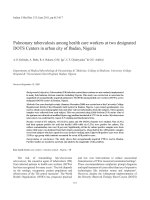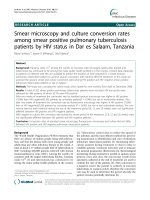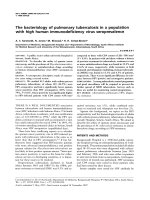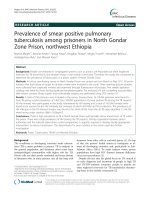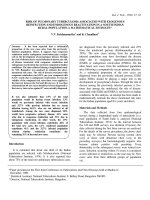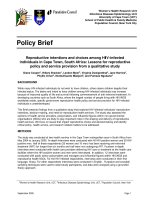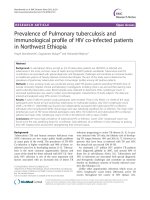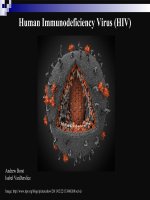PULMONARY TUBERCULOSIS AMONG HUMAN IMMUNODEFICIENCY VIRUS (HIV) INFECTED PATIENTS IN THE ERA OF HIGHLY ACTIVE ANTIRETROVIRAL THERAPY (HAART) IN DAR ES SALAAM MUNICIPAL, TANZANIA pdf
Bạn đang xem bản rút gọn của tài liệu. Xem và tải ngay bản đầy đủ của tài liệu tại đây (220.44 KB, 38 trang )
1
PULMONARY TUBERCULOSIS AMONG HUMAN
IMMUNODEFICIENCY VIRUS (HIV) INFECTED PATIENTS
IN THE ERA OF HIGHLY ACTIVE ANTIRETROVIRAL
THERAPY (HAART) IN DAR ES SALAAM MUNICIPAL,
TANZANIA
Author: Veneranda Masatu Bwana
(MPH 2009)
Supervisor: Associate Professor Lennarth Nyström
Umeå International School of Public Health, Umea University,
Sweden.
2
ABSTRACT
Aim: The aim of this study is to estimate the prevalence of pulmonary Tuberculosis (TB) among
HIV-infected patients and to estimate the effect of HAART on the development of pulmonary
TB.
Subjects and Methods: During February 2009 a cross-sectional study of 174 HIV positive
patients on HAART 15-49 years old was performed in Dar es Salaam, Tanzania. Information
was collected at exit interviews and from the patients’ case files using a questionnaire. Data
analysis was done using SPSS.
Results: There were 102 males (59%) and 72 females (41%). The median age was 37 years
(Range: 16-49 years). All but three was in first line of HAART treatment and good adherence
was reported by 80%. The prevalence of TB before HAART initiation was found to be higher
than after HAART initiation (29 % vs. 6.0 %; p< 0.0001). Among those diagnosed with TB after
HAART the median time between TB diagnosis and at HAART initiation was 146 days (Range
14-1481 days). The median CD4 Count at time of TB diagnosis was 111cells/µl (Range: 6-418
cells/µl).
Conclusion: HAART has largely contributed to the reduction of prevalence of TB among
people living with HIV. However more strategic preventive measures that enhance body
immunity among HIV patients are highly needed as early as possible before they develop active
TB. A sustainable effective intervention especially through vaccination is highly recommended.
Keywords: Pulmonary Tuberculosis, Prevalence, HIV infection, HAART, Dar es Salaam,
Tanzania
3
CONTENT
CONTENT PAGE
TITLE 1
ABSTRACT 2
ABBREVIATIONS 4
INTRODUCTION AND BACKGROUND 5
LITERATURE REVIEW 6
Problem statement 9
Rationale 9
Aims 10
SUBJECTS AND METHODS 11
Study area 11
Health care system 12
Programme for care and treatment of HIV/AIDS patients 12
Programme for care and treatment of tuberculosis and leprosy patients 14
Study design 18
Study population 18
Sampling procedure 18
Sampling method 19
Measure instruments 19
Data collection 19
Statistical analysis 19
Ethical issues 20
RESULTS 20
DISCUSSION 27
CONCLUSION 30
ACKNOLEDGEMENTS 30
REFERENCES 31
APPENDIX I: Questionnaire: English version 35
4
ABBREVIATIONS
ABBREVIATION IN PLAIN TEXT
AIDS Acquired Immunodeficiency Syndrome
ARV Antiretroviral
ART Antiretroviral therapy
CTC Care and Treatment Clinic
DMO District Medical Officer
DOT Directly Observed Therapy (Short course)
GUT Genital Urinary Tract
FDC Fixed Dose Combination
HAART Highly Active Antiretroviral Therapy
HIV Human Immunodeficiency Virus
MDH Muhas Dar es Salaam City Harvard Collaborative Project
MoHSW Ministry of Health and Social Welfare
MUHAS Muhimbili University of Health and Allied Sciences
NACP National AIDS Control Programme
NMCP National Malaria Control Programme
NRTI Nucleoside Reverse Transcriptase Inhibitor
PI Protease Inhibitor
PMORALG Prime Minister’s Office for Regional Administration and Local
Government
TBL Tuberculosis and Leprosy
TB Tuberculosis
UN United Nations
WHO World Health Organization
5
INTRODUCTION AND BACKGROUND
Tuberculosis (TB) is an infectious disease caused by the bacteria Mycobacterium
tuberculosis.TB is a major disease burden globally. In 2006 it was estimated that there was 9.2
million incident cases, and among these 0.7 million cases were HIV-positive. The HIV
prevalence in TB patients is less than 1% in the Western Pacific but 22% in Africa, however, in
countries with the highest HIV prevalence; more than 75% of cases of TB are HIV-associated.
Southern Africa has the highest prevalence of HIV infection and had the highest incidence of TB
before the HIV/AIDS era (Badri et al, 2002; WHO, 2008).
Tuberculosis commonly present with atypical symptoms. Mycobacterium tuberculosis was
isolated from 9% of adults with acute pneumonia in Kenya (Scott et al, 2000) and 23% of febrile
hospitalized HIV-infected in Dar es Salaam, Tanzania (Archibald et al, 1998). Besides that,
Kwesigabo and co-workers (1999) showed that the prevalence of pulmonary TB among HIV-1
patients was 59% among hospitalized patients in Kagera region, Tanzania.
In Tanzania, the HIV prevalence among new smear-positive TB patients increased from 28% in
1991-1993 to 40% in 1994-1998 (Range et al, 2001). The largest increase was observed in the
youngest birth cohorts suggesting ongoing HIV transmission. Furthermore it was estimated that
86% of new smear-positive TB in patients with HIV infection was directly attributable to HIV.
The advent of highly active antiretroviral therapy (HAART) has greatly contributed to the
reduction of the severity of HIV infection and in one way or another will consequently reduce
the susceptibility of opportunistic infections among HIV patients. The therapy involves a
combination of protease inhibitors taken with nucleoside reverse transcriptase inhibitors (NRTI)
which are used in treating AIDS and HIV. The usual HAART regimen combines three or more
different drugs from different classes such as
• two NRTIs and one Protease Inhibitor (PI)
• two NRTIs and two PIs
• two NRTIs and one non-NRTI (MoHSW.URT. NACP.2008)
6
Basically there are two types of TB: pulmonary TB (whereby the bacteria Mycobacterium
tuberculosis typically affects the lungs) and extra pulmonary TB (whereby the bacteria affect
other organs). According to the Tanzania national tuberculosis and leprosy (TBL) program
policy guidelines, the disease in adults is classified into three categories: smear-positive
pulmonary TB, smear-negative pulmonary TB and extra-pulmonary TB. TB may arise at a time
when body immunity is low and conditions like HIV infection, diabetes, malnutrition, recurrent
infections are known to be an important cause of reactivation of the TB infection. In recent years
TB has become prevalent among people living with human immunodeficiency virus (HIV)
which poses a major public health problem especially in Sub-Saharan Africa including Tanzania
(MoHSW.URT. NTLP. 2006; WHO, 2008).
Tuberculosis continues to be among the major public health problems in Tanzania. The number
of cases has increased six-fold between 1983 and 2006 and the majority of the cases appear in
young adults (15-44 years), the same age group which is mostly affected by HIV/AIDS
(MoHSW. URT.NTLP. 2006). This study aims at estimating the prevalence of pulmonary TB
(all patients diagnosed by attending Medical Officer as TB case) among HIV patients and to
estimate the effect HAART on pulmonary TB in order to improve the survival among patients
with HIV associated TB.
LITERATURE REVIEW
Literature search
A literature search was performed using PubMed, WHOs website Hinari, and specific journals
(Clin Infect Dis, BMC Oral Health, Emerging Infectious Diseases, Int J Tuberculosis Lung Dis,
Am J Resp Critical Care Med, Science, BMJ, J Acquir Immune Defic Syndr and AIDS). The
following keywords were used in PubMed:
• HIV infection and TB and opportunistic infection and Sub-Saharan Africa (5 articles, 1
review)
• Tuberculosis and HAART and HIV infection and Africa (3 articles, 1 review)
• Tuberculosis and HIV infection and mortality and Sub-Saharan Africa (4 articles)
7
• Antiretroviral adherence and East Africa (No articles)
• Antiretroviral adherence and Tanzania (2 articles)
• HIV infection and TB and Tanzania (2 articles).
Antiretroviral treatment
The major goal of antiretroviral treatment scale-up is to reduce HIV-associated morbidity and
mortality. Tuberculosis case-fatality rates (proportion of patients dying while on antituberculous
treatment) in Africa are 16–35% in HIV-positive cases not receiving antiretroviral treatment and
4–9% in HIV-negative cases (Mukadi et al, 2001). Increased mortality during the first month of
treatment seems largely attributable to the TB itself (Mukadi et al, 2001). The greatest proportion
of HIV positive associated TB patients are found at CD4 count <200 cells/µl and they also have
the highest mortality rates (Ackah et al, 1995). (CD4 cells are type of lymphocyte cells (white
blood cells) that form an important part of the immune system. Human Immunodeficiency virus
most often infects these cells) (MoHSW. URT. NACP. 2008).
Several studies from different countries have showed that antiretroviral drugs reduce the
incidence of TB in HIV-infected people by 80% or more, with the greatest effect at the lowest
CD4 counts (Badri et al, 2002; Girardi et al, 2000). However, clinically, immune dysfunction
persists even during successful antiretroviral treatment and the TB incidence remains high, even
at high CD4 counts (Girardi et al, 2000). The risk of recurrent disease in patients with previous
HIV-related TB is also high, suggesting a need for secondary prevention. Furthermore the risk of
active TB after HAART initiation was significantly higher in patients with a previous history of
TB than in those with no TB history (Churchyard et al, 2003; Seyler et al, 2005).
Tuberculosis
Tuberculosis is an aggressive opportunistic infection that arises at higher median CD4 count
compared with other AIDS-related diseases conditions. In Cote d’Ivoire smear-positive TB
patients presented with a median CD4 count of 257 cells/µl (Range: 200-500 cells/µl) (Ackah et
al, 1995). However, WHO current guidelines recommend treatment for patients with
symptomatic HIV or a CD4 count of <200 cells/µl for resource-poor settings (WHO, 2008).
8
Therefore, the potential effect of antiretroviral treatment on the TB incidence is reduced because
many HIV-infected patients with TB present before antiretroviral drugs are prescribed.
In contrary, Lawn et al (2005) showed that TB developed also among individuals who were
responding to HAART. They also demonstrated that among 27 patients who developed TB, the
median plasma viral load at the time TB was diagnosed (2.98 log10copies/ml) was twice as low
as that at enrolment (5.38 log10copies/ml) and the median CD4 cell count at time of TB
diagnosis (198 cells/µl) was significantly higher than at baseline (112 cells/µl). This suggests
that TB incidence and mortality will be reduced if antiretroviral drug coverage is high, start early
and is combined with TB preventive treatment (Williams et al, 2003).
Opportunistic infections
Opportunistic infections continue to cause morbidity and mortality in patients with HIV-1
infection throughout the world. However, HAART potent combination has reduced the incidence
for certain patients with access to care. Hamza and colleagues (2006) showed that oral
candidiasis was the commonest oral lesion accounting for 24% among HIV-associated oral
lesions, followed by mucosal hyper pigmentation (4.7%). Ravera and co-workers (1999) showed
that 91% of the participants (42 females, 35 males) had both oral and oesophageal candidiasis
and 47% (n=40) had oesophageal symptoms and all had oesophageal candidiasis at endoscope.
Furthermore, Kwesigabo et al (1999) showed that the prevalence of herpes zoster and other skin
manifestations was 86% among HIV-1 infected patients.
Adherence to antiretroviral treatment
Treatment of patients already on HAART for TB is complex because of the high number of
drugs administered simultaneously which poses practical problems related to adherence and side-
effects (Bonnet et al, 2006). Adherence levels in Africa have been found to be better than in the
United States. However, at all the facilities studied in Botswana, Tanzania and Uganda, around
one out of four antiretroviral users failed to achieve optimal adherence, risking drug resistance
and negative treatment outcomes, which make them more susceptible to other infections (Hardon
et al, 2007).
9
In a study done in Botswana 54% (59/109) of patients reported optimal adherence (defined as
completing ≥95% of prescribed doses) (Weiser et al, 2003). In contrast, in Tanzania 84%
(126/150) patients reported complete adherence and 16% (24/150) patients reported incomplete
adherence (incomplete adherence was defined as self reported adherence completing <100% of
the prescribed doses) (Ramadhani et al, 2007). In comparable studies conducted in developed
countries, rates of incomplete self-reported adherence ranged from 40% to 70% (Incomplete
adherence was defined as self reported adherence completing < 80% of the prescribed doses)
(Chesney et al, 2001).
Thus TB is a major public health problem, which poses the greatest burden among HIV positive
patients suggesting the need for further studies to estimate the prevalence of pulmonary TB as
well as to estimate the effect of HAART on the development of pulmonary TB among HIV
infected patients.
Problem statement
The prevalence of TB is increasing in many countries and is the leading infectious cause of death
worldwide. Infection with HIV, likewise increasing in prevalence, has emerged as the most
important predisposing factor for developing TB in people co-infected with Mycobacterium
tuberculosis. In Africa, TB is often the first manifestation of HIV infection, and it is the leading
cause of death among HIV-infected patient (MoHSW.URT.NTLP. 2006; WHO, 2008).
Archibald et al (1998) showed in a study done in Dar es Salaam, Tanzania that Mycobacterium
tuberculosis was isolated from 23% of febrile HIV-infected hospitalised patients. In addition
Kwesigabo et al (1999) showed that the prevalence of pulmonary TB among HIV-1 patients was
59% among hospitalized patients and Range et al (2001) estimated that 86% of new smear
positive TB in patients with HIV infection was directly attributable to HIV.
Rationale
The Millennium Development Goal number 6 aims at combating HIV/AIDS, malaria and other
diseases by 2015. In this regard, TB is one among other diseases. The Stop TB strategy of global
TB control (launched by the Stop TB Partnership in 2006) aims at reducing by 50% of the global
10
burden of TB (per capita prevalence and death rates) by 2015 and reducing the global incidence
of active TB by less than 1 case per million per year by 2050. Tanzania among other countries
has also made efforts through its national tuberculosis and leprosy program (NTLP) towards
achieving this goal in line with the MDGs.
Monitoring of the preventive programmes to ensure that they reach the global targets for TB
control is crucial especially in Africa with limited resources. Consequently a comprehensive
study that estimate the effect of HAART on development of pulmonary TB among HIV infected
patients is important so that preventive measures can be instituted and eventually improve the
management of HIV patients in a comprehensive manner.
In Tanzania TB continues to be among the major public health problems. Furthermore, the
distribution of TB in the country varies e.g. the Dar es Salaam Region with 6% of the population
contribute about 24% of all cases of TB (MoHSW.URT. NTLP. 2006). Therefore TB is still a
major global public health problem and there is a need to allocate more resources and to establish
more sustainable preventive strategies especially in poor resource and developing countries.
Aims
The aim of this study is to estimate the prevalence of pulmonary TB among HIV-infected
patients. The specific aims are that among HIV-positive patients on HAART:
• To estimate prevalence of TB by age and sex
• To estimate the effect HAART on TB disease
• To estimate duration between TB diagnosis and at initiation of HAART
• To estimate effect of TB on the CD4 Count level at TB diagnosis, HIV diagnosis and at
initiation of HAART
• To assess adherence to ARV drugs by age, sex and co-morbidity
11
SUBJECTS AND METHODS
Study area
The study was conducted in the capital of the United Republic of Tanzania, Dar es Salaam
situated on the East coast of Tanzania. It includes the municipalities of Ilala, Temeke, and
Kinondoni and borders the Indian Ocean to the East and the Coastal region on all other sides
(Pwani). The climate is typically tropical, with hot weather throughout the year (Range: 26°–
35°C) and two rainy seasons, short rains in November–December and long rains in March–May.
Kiswahili is the most spoken language and is the national language.
The main productive economic activities include agriculture, livestock, natural resources, fishing
and large and small scale industries. The main business activities include insurance, travel,
clearing and forwarding agencies, hoteliers, printing press to distributors of industrial
commodities and petty traders.
Some demographic and public health indicators for Dar es Salaam and the whole country are
presented in Table 1. The main health problems in the region are malaria, diarrhoeal diseases,
upper respiratory tract infections, pneumonia, anaemia, intestinal worms, sexual transmitted
diseases and HIV/AIDS (MOH, Health Statistics Abstract. URT.1999; Kitua et al, 2008).
Table 1. Some demographic characteristics for Tanzania and Dar es Salaam by sex (M=Males,
F=Females)
Source: MOH, Health Statistics Abstract, Dar es Salaam. June 1998 and November, 1999
Source: National Bureau of Statistics, Dar es Salaam-Tanzania, NBS 2007
Demographic and public health indicators Tanzania (Year) Dar es Salaam (Year)
Population size 39,394,223 (2007) 2,497,940 (2002)
Life expectancy at birth (years) for both sex 51 (2007) -
Life expectancy at birth (years) M: 49, F: 52 (2007) -
Crude birth rate 36/1000 (2007) 28.6/1000 (1999)
Crude death rate 14/1000 (2007) 12.8/1000 (1999)
Maternal mortality rate/100,000 live births 578/100,000 (2005) 669/100,000 (1999)
12
Infant mortality rate/ 72/1000 (2007) -
Under-five mortality rate/ 112/1000 (2005) -
Total fertility rate (children/15-49 year) 6 (2002) -
Population growth rate (%) 2 (2006) 4 (2002)
Literacy rate (%) M: 76%, F: 62%
(2002)
M: 92%, F: 69%
(1998)
The health care system
The government is the main provider of health services in Tanzania. The health care system in
Tanzania is fairly well distributed, about 80% of the population has access to health services and
over 90% of the population live within 10km. The Ministry of Health and Social Welfare
(MoHSW) and the Prime Minister’s Office for Regional Administration and Local Government
(PMORALG) are jointly responsible for the delivery of public health services. The national
health system is based on decentralising services to Local Government Authorities.
The health care system is operating at three levels, central, regions and districts. The MoHSW
plays a role at central level as it is responsible for policy formulation and develop guidelines in
order to facilitate the implementation of that policy. Regional Health Management Teams in
mainland Tanzania, headed by a regional medical officer, are responsible to interpret these
policies into actions and monitor their implementation in their districts. The regional medical
officer report through the Regional Administrative Secretary to the MoHSW on issues related to
technical management and to the PMORALG on issues related to health administration and
management of health services. The Council Health Management Teams, headed by a district
medical officer, are responsible for Council health services at dispensaries, health centres, and
district hospitals. The district medical officer is in charge of all district health services and is
answerable to the local government authority and is responsible to the regional medical officer
(MoHSW. URT. National Health Policy. 2003).
Programme for care and treatment of HIV/AIDS patients
The main purpose of antiretroviral care and treatment programme is to provide care to HIV
patients. Attention is paid to a number of issues including aggressive efforts to identify HIV-
13
positive individuals, developing a team approach to treatment, strict observation of standard
protocols by clinicians, and strict application of patient classification and treatment schedule
models (MoHSW. URT.NACP, 2008).
Care and Treatment Clinics (CTC) have been established at selected health care facilities to
provide HIV care and treatment services. Once enrolled, every CTC clients are also linked to a
wide range of other services including reproductive health and family planning, social and
spiritual support and home-based care services. Since TB and HIV services have been integrated
in every CTC and TB screening has become a routine for all HIV patients during their follow up
visit (MoHSW. URT.NACP, 2008).
Outline of care and treatment
The main aim of the care and treatment is to improve the overall health and to reduce
transmission and to slow down the progression of disease on individual and population level. In
addition to routine clinical care, each patient may fall into three categories with specific clinical
goals of treatment (Table 2):
Table 2. Determination of CD4 Count patient category
Category HIV/AIDS CD4 cell count/µl CD4 determined
Mildly immuno-suppressed HIV+ >350 6 month
Moderately immuno-suppressed HIV+ 200-350 4 month
Treatment-ready AIDS <200 Monthly
Antiretroviral therapy
Antiretroviral drug treatment in Tanzania started in 2004 and all services including ARV drugs
are provided free of charge in every CTC. Currently the following drugs that are available in
Tanzania: Drugs under the class NRTIs are Zidovudine, Stavudine, Lamivudine, Abacavir,
Emtricitabine, Didanosine; Non NRTIs are Nevirapine and Efavirenz; and PIs are
Lopinavir/Ritonavir and Atazanavir.The first line recommended regimen in Tanzania is
Zidovudine/Lamivudine/Nevirapine or Zidovudine/Lamivudine/Efavirence. Also alternatives
regimes are available in specific situations. Patients with severe anaemia will receive Stavudine
14
instead of Zidovudine ande non-pregnant patients who cannot tolerate Nevrapine will receive
Efavirence. Also patients who develop TB while on antiretroviral therapy will receive Efavirence
instead of Nevirapine (MoHSW.URT. NACP, 2008). According to the WHO clinical stages for
HIV positive patients, there are four stages based on clinical symptoms. Based on the WHO
clinical staging for adults and adolescents the eligibility criteria for initiation of ARV are
grouped into three (Table 3).
Table 3. Clasification of the patients by eligibility criteria to start antiretroviral therapy
Patient category with Antiretroviral treatment
WHO stage 4 Eligible regardless of CD4 count
WHO stage 3, CD4 ≤350 Eligible
CD4 ≤200 Eligible regardless of WHO clinical stage
Special categories for considerations of antiretroviral therapy (ART) in TB and HIV co-infected
patients according to Tanzania National AIDS Control Programme, 2008. Tanzania
Antiretroviral therapy improves the quality of life and greatly improves survival of people living
with HIV/AIDS. It is a lifelong treatment requiring a high adherence rate to achieve long term
benefits and minimize the development of drug resistance. ART should be offered to all eligible
TB/HIV positive patients (Table 4).
Table 4. Special categories for considerations of ART in TB and HIV co- infected patients
Patient category with Consideration for antiretroviral therapy
CD4> 350 Treat TB first, re-assess for ART after completion of TB treatment
CD4 200-350 Treat TB first for two months before starting ART
CD4 <200 or WHO stage 4 Begin ART as 2 weeks after TB treatment initiation
Programme for care and treatment of tuberculosis and Leprosy (TBL)
At national level the TBL central unit is responsible for coordination of all activities pertaining
to TBL in the country including policy formulation, planning, monitoring, evaluation, resource
mobilization and coordination of drugs and supplies procurement and distribution. It is also
responsible for giving primary health education; provide preventive and curative and
15
consultation to the patients. At regional level a regional TBL coordinator work under the
regional medical doctor and at district level a district TBL coordinator is responsible to the
district medical officer for the implementation and coordination of TBL control activities within
the district. The national TBL programme has extended its activities up to the village level to
involve the community in treatment.
Community-based direct observation treatment involves village health workers, village leaders,
religious people and community members. These were well trained by ommunity Health
Management Team (CHMT) who are involved in formulations of Guidelines for community-
based direct observation treatment (MoHSW.URT.NTLP, 2006). Since AIDS and TB are closely
related, they have integrated AIDS education together with TB and the district tuberculosis and
leprosy coordinator continue to cooperate closely with the district AIDS control coordinator. All
TB/HIV services, including care and treatment of patients with TB/HIV co-infection, have been
integrated together in every CTC and TB and antiretroviral drugs are provided in one section
(MoHSW.URT.NTLP.2006).
Definition of TB patients’ category in adults according to National Tuberculosis and Leprosy
Programme, Ministry of Health and Social Welfare, 2006.Tanzania
Smear positive pulmonary TB:
“Tuberculosis in a patient with at least two initial smear
examinations positive by direct microscopy for Acid Fast Bacilli (AFB positive), or TB in a
patient with one initial smear examination positive by direct microscopy and positive by culture
for mycobacteria. Or TB in a patient with one initial smear examination positive by direct
microscopy for Acid Fast Bacilli (AFB positive) and X-ray abnormalities suggestive of active
tuberculosis as determined by the treating Medical Doctor.”
Smear negative pulmonary TB:
“Tuberculosis in a patient with three initial negative smear
examinations by direct microscopy for Acid Fast Bacilli (AFB negative) and non-response to a
course of broad-spectrum antibiotics, and again three negative smear examinations by direct
microscopy, and X-ray abnormalities suggestive of active TB as determined by the treating
medical doctor .Or TB in a patient with three initial smear examinations negative by direct
microscopy but positive by culture for mycobacteria.”
16
Extra-pulmonary TB:
“Tuberculosis in organs other than the lungs proven by one culture
positive specimen from an extra-pulmonary site or histopathological evidence from a biopsy.
Or TB based on strong clinical evidence, including macroscopic evidence of specimen
inspection, consistent with active extra-pulmonary Tuberculosis and the decision by a medical
doctor to treat with a full course of anti-tuberculous therapy” (MoHSW.URT.NTLP.2006).
Tuberculosis treatment regimens
The first short-course regimen of 8 months was introduced in Tanzania in 1987 for sputum smear
positive patients only. Since July 2001 non-infectious patients also receive a short-course regimen.
A
six months short-course regimen for new smear-positive, smear-negative and extra pulmonary
TB was introduced in 2006.
TB regimens are divided into the initial phase (intensive) and
continuation phase. In the intensive phase the majority of TB bacilli are rapidly killed and infectious
patients become non-infectious within one to two weeks. Short-course chemotherapy has a very high
success rate if properly applied in a patient with TB diagnosed in time. The length of the regimen
varies from 6 to 8 months depending on the patient’s category of disease. The six months regimen,
which contains rifampicin throughout, is slightly more effective in preventing re-activation of
dormant bacilli, reducing relapse especially in HIV positive tuberculosis patients.
Since 2006 the
treatment of TB is available as a fixed dose combination (FDC) which contains 2, 3 or 4 drugs
depending on the patients’ categories (either Smear-positive pulmonary TB or Smear-negative
pulmonary TB or Extra-pulmonary TB). There are four essential first line drugs which are also
available in combinations, and in line with WHO recommendations, these are isoniazid,
rifampicin, pyrazinamide, ethambutol. Such combinations are 4 FDC (rifampicin, isoniazid,
pyrazinamide, ethambutol), 3FDC (rifampicin, isoniazid, pyrazinamide), 2FDC (rifampicin,
isoniazid) and 2FDC (ethambutol, isoniazid). All services for TB patients including anti TB
drugs are provided free of charge in every health facility (MoHSW.URT.NTLP.2006).
Preventive treatment for tuberculosis
Isoniazid Preventive Treatment (IPT) in HIV positive patients:
The aim of preventive treatment
is to prevent progression from TB infection to disease. Isoniazid given at a dose of 5 mg/kg daily
for 6 months has been recommended as an effective preventive treatment. Currently, there is no
enough evidence and experience of the impact of large scale preventive treatment in Tanzania.
17
Furthermore, IPT is not an alternative for the DOTS strategy for controlling TB in Tanzania.
However, IPT is recommended in HIV positive patients who do not have active TB disease and
who have an increased chance of contracting TB infection. This will in one way or another
prevent many cases of active TB. Therefore if IPT is given, active TB must always be excluded
first (sputum examination, clinically, history, chest X-ray) (MoHSW.URT.NTLP.2006).
BCG Vaccination:
BCG (Bacille Calmette-Guerin) is a live attenuated vaccine derived from
Mycobacterium bovis. It was first used in 1921. The vaccine is given intra-dermally in the upper
part of the right arm at a dose of 0.05 ml to all neonates shortly after birth. BCG protects young
children and it has considered more effective by 80% against disseminated and severe forms of
tuberculosis, e.g. TB meningitis, miliary TB. It has been observed that, BCG has little or no
protection against the development of TB in adults. Furthermore, the WHO recommends that in
countries with a high prevalence of TB, like Tanzania, BCG should be given to all neonates,
regardless of the HIV status, immediately after birth. The possible benefits of BCG outweigh the
possible disadvantages. However, BCG should not be given to children who present with clear
signs and symptoms of HIV-disease or AIDS due to higher risk of development of disseminated
BCG (MoHSW.URT.NTLP.2006, Waddell et al 2001). Despite the widespread use of BCG, for
more than half century, TB has been growing dramatically in the world, fueled by the increased
susceptibility of HIV-infected people to TB. The BCG vaccine for prevention of TB given in
childhood in many countries ceases to be effective. TB remains the largest cause of death
worldwide which calls attention to scientists and researchers (Haile and Kallenius 2005,
McMurray ND 2003, Matee et al 2007)
Mycobacterium vaccae vaccine:
Mycobacterium vaccae vaccine is a whole inactivated
mycobacterium. It has been in development for more than 16 years. It had been tested for safety
and immunogenicity in a variety of previous human studies in Europe, North America and Africa
(Vuola et al 2003, Waddell et al 2000). Tanzanian and United State researchers have recently
announced a discovery of a Mycobacterium vaccae vaccine that can reduce TB infections by
almost 40 per cent among HIV infected people. The vaccine was given to study volunteers in a
five dose series over a period of 12 months in a large scale placebo-controlled randomized
clinical trial conducted in Tanzania. This study was recently in phase three study designed to test
18
the safety and efficacy of a TB vaccine in a large population of HIV-positive people. However
there still remain questions to researchers about the true degree of efficacy of the vaccine (Von
Reyn CF et al 2008).
Study design
A cross sectional study of HIV-positive patients on HAART was performed in the government
HIV-clinics of Amana and Mwananyamala in Dar es Salaam, Tanzania during February 2009.
Study population
The study population were non-pregnant HIV positive patients on HAART 15-49 years old
living in Dar es Salaam. Children and pregnant women were not included as they follow a
special HIV programme. Patients with chronic conditions like diabetes, chronic renal failure,
cancer and malnutrition were excluded.
Sampling procedure
There are one national, three municipal-government hospitals, several dispensaries and several
private hospitals in Dar es Salaam. At some of these units there are government supported HIV
clinics. This study was conducted in government HIV clinics due to difficulties in accessing
private facilities. Presently there are 14 government HIV clinics in charge of the HAART
programme; six in Ilala district (Tabata, Amana, Buguruni, Infectious Disease Control,
Muhimbili National Hospital, Mnazimmoja), four in Kinondoni district (Sinza, Kimara,
Tandale, Mwananyamala) and four in Temeke district (Temeke, Mbagala, Vijibweni and
Kigamboni). The number of patients at each clinic varies. The old clinics (Muhimbili National
Hospital, Amana, Infectious Disease Control, Mwananyamala and Temeke) serve between
15,000 and 16,000 patients while the new serve between 1000 and 1200 patients.The study area
was stratified by district. Two HIV clinics were selected, one in Ilala district (Amana) and one in
Kinondoni district (Mwananyamala).In every HIV clinic clients were conveniently selected from
HAART and TB/HAART sections after their exit from Medical officer and having finished their
daily normal follow up schedule.
19
Sampling method
Convenience sampling method was the main method that was used during data collection in
every CTC. A total of 174 study subjects were enrolled in this study, 63 from Amana and 113
from Mwananyamala.
Measure instrument
Questionnaire was used for data collection and it was structured based on knowledge background
of the HIV related infection as well as all co-morbidity associated with HIV infection. The
questionnaire contained question on basic socio-demographic characteristics, prior history of
TB, behavior on ART adherence and smoking, clinical diagnostic information of co-morbidity
including TB, clinical stage of HIV; treatment of the patient, CD4 counts and sputum smear for
AFB. Questionnaire was translated from English to Swahili version. It is the Swahili version that
was used for data collection.
Data collection
Information was collected at exit interviews and from the clinical records by using a pre-tested
questionnaire. At each HIV clinic the investigator identified all patients who had started
HAART (Non-pregnant HIV positive patients on HAART 15-49 years as per inclusion criteria)
and she conveniently enroll study participants and then she recorded basic social demographic
characteristics, history of smoking, occupation, behavior on ART adherence, past history of
pulmonary TB; by administering a questionnaire to every participant. Furthermore other clinical
diagnostic information of co-morbidity including TB, clinical stage of HIV; treatment of the
patient, CD4 counts and sputum smear for AFB was extracted from the patient’s case file. All
patients were two months old and above on HAART at the time of data collection.
Statistical analysis
All questionnaires were assigned a serial number. Open ended questions were coded before
computerisation using Epi Info. Data cleaning and analysis was done using SPSS. Pearson chi-
square, Fisher’s exact test were used to compare group difference between categorical variables.
A p value > 0.05 are considered as non significant. Good adherence by self reporting was defined
20
as missing ≤1 of the prescribed doses since started their antiretroviral treatment (that means
completing more than 95% of the prescribed doses).
Ethical consideration
Ethical clearance was obtained from Medical Research Coordinating Committee at Tanzania
National Institute for Medical Research. At the health facility level where ARV and TB activities
are provided permission was obtained from the facility management and later to the health
workers, and then to the study population. Informed consent was obtained from study
participants enrolled into the study by using the language conversant to the participants.
Confidentiality was strictly maintained for study subjects.
RESULTS
During February 2009 174 HIV patients who were on HAART programme were enrolled and out
of these 61 (35%) was pulmonary TB positive; 50 of these were positive already at initiation of
HAART. The prevalence of TB before HAART initiation was found to be higher than after
HAART initiation (29 % vs. 6.0 %; p < 0.0001). (Figure 1, Table 5).
Figure 1. Flowchart illustrating current status of tuberculosis among HIV patients
Mwananyamala
n=111
Amana
n=63
HIV patients on HAART
n= 174
TB positive
n=61
TB negative
n=113
After HAART
n=11
Before HAART
n=50
21
There were 102 males (59%) and 72 females (41%). All but three was in first line HAART
treatment (Table 5). The prevalence of TB after HAART was higher among patients with a
previous history of TB than in those with no TB history (12% vs. 4.0%; p=0.04) (Table 6).
Table 5. HAART treatment line by age, sex and TB status
Characteristic HAART treatment line Total
1
st
2
n
d
Sex:
Female 99 3 102 (59%)
Male 72 0 72 (41%)
Age (years):
15-29 26 0 26 (15% )
30-49 145 3 148 (85%)
TB status:
After HAART 11 0 11 (6.0%)
Before HAART 50 0 50 (29%)
Negative 110 3 113 (65%)
Total 171 (98%) 3 (2.0%) 174 (100%)
Table 6. Tuberculosis status by previous history of TB
Previous history
of TB
TB status Total
After Before Negative
Yes 6 (12%) 1 (2.0%) 42 (86%) 49 (100%)
No 5 (4.0%) 49 (39%) 71 (57%) 125 (100%)
Total 11 (6%) 50 (29%) 113 (65%) 174 (100%)
Proportion of smear negative pulmonary TB was found to be higher than smear positive
pulmonary TB among patients with a previous history of TB (32% vs. 2.0%) (p=0.002).
Proportion of smear negative pulmonary TB was found to be higher than smear positive
pulmonary TB among those diagnosed with TB after HAART (37% vs. 9.5% (p=0.261), but
results are non significant (Table 7).
22
Table 7. Sputum for Acid Fast Bacillus by TB previous history and TB status
TB AFB smear Total
Positive Negative
Previous history:
Yes 1 (2.0 %) 6 (32 %) 7 (11% )
No 41 (98 %) 13 (68 %) 54 (89%)
Status:
After 4 (9.5 %) 7 (37 %) 11 (18% )
Before 38 (90 %) 12 (63 %) 50 (82 %)
Total 42 (100%) 19 (100%) 61 (100%)
The overall prevalence of pulmonary TB among the studied patients was found to be higher than
other opportunistic infections followed by herpes zoster and other skin manifestation of HIV
infection (Table 8). There was no difference by socio-demographic characteristics and TB status
(Table 9).
Table 8. Proportion distribution of opportunistic infections
Opportunistic infections Positive Negative Total
TB 61 (35%) 113 (65%) 174
Oral candidiasis 22 (13%) 152 (87%) 174
Herpes zoster & other skin manifestation of HIV infection 46 (26%) 128 (74%) 174
Venereal diseases & other GUT conditions 19 (11%) 155 (89%) 174
Gastrointestinal conditions 12 (7%) 162 (93%) 174
23
Table 9. Socio demographic characteristics by TB status
Socio-demographic characteristics TB status Total
Positive Negative
No % No %
Age(years):
15-29
10 38% 16 62% 26
30-49
51 34% 97 66% 148
Sex:
Males 30 42% 42 58% 72
Females 31 30% 71 70% 102
Occupation:
Self-employed 32 41% 46 59% 78
Employed 14 22% 49 78% 63
Unemployed 9 53% 8 47% 17
H/wife 6 38% 10 63% 16
Education:
Primary and no education (n=2) 38 35% 70 65% 108
Secondary and higher (n=2) 23 35% 43 65% 66
Smoking status:
Current and previous 18 43% 24 57% 42
Never smoke 43 33% 89 67% 132
Marital status:
Single 26 44% 33 56% 59
Separate/widow 9 28% 23 72% 32
Married 26 31% 57 69% 83
Total 61 35% 113 65% 174
The highest proportions of HIV associated TB patients was found among patients with the CD4
Count ≤200 cells/µl (Table 10). The overall median CD4 Count at which TB was diagnosed was
found to be 111 cells/ µl (Range 6-418 cells/µl) (Table 11). The median CD4 Count among those
diagnosed with TB after HAART initiation was (167 cells/µl) higher than for those diagnosed
24
with TB before HAART initiation (108 cells/µl). Among those diagnosed with TB after HAART
initiation; their median CD4 Count at time TB was diagnosed was (167 cells/µl) lower than their
median CD4 Count at HIV diagnosis (190 cells/µl). The median age for all HV positive patients
was 37 (Range: 16-49).
Table 10. Proportion distribution of TB status by CD4 Count at HAART initiation and at TB
diagnosis
CD4 Count (cells/µl) TB current status Total
After Before Negative
At HIV diagnosis:
1-200 7 39 81 127 (80%)
201-350 3 10 12 25 (16%)
351-9999 1 0 6 7 (4.0%)
Total 11 (7.0%) 49 (31%) 99 (62%) 159 (100%)
At HAART initiation:
1-200 7 39 86 132 (83)
201-350 4 10 10 24 (15%)
351-9999 0 0 4 4 (3%)
Total 11 (7.0%) 49 (31%) 100 (62%) 160 (100%)
At TB diagnosis:
1-200 6 39 45 (79%)
201-350 1 10 11 (19%)
351-9999 1 0 1 (2.0%)
Total 8 (14%) 49 (86%) 57 (100%)
25
Table 11. Median level of the CD4 Count and Age by TB status and overall HIV patients
CD4 Count (cells/µl) Median and Range
At TB diagnosis:
Total TB positive 111 (6-418)
After 167 (48-418
Before 108 (6-335)
At HIV diagnosis:
Total TB positive 110 (2-358)
After 190 (2-358)
Before 108 (6-335)
At HAART initiation:
All HIV patients 111 (2-489)
Total TB positive 110 (6-335)
After 190 (38-312)
Before 108 (6-335)
Age (years):
Median and Range
All HIV patients 37 (16-49)
Total TB positive 36 (16-49)
After 31 (16-47)
Before 36 (25-49)
Adherence to antiretroviral drugs has been studied among 174 HIV patients by self reporting of
the amount of doses missed since enrolled in HAART programme. It has been found that 80%
(139/174) reported good adherence, while 20% (35/174) reported poor adherence (Table 12).
Greater proportion of TB positive patients have been observed with good adherence than TB
negative patients (p=0.027). Also greater proportion of HIV patients presented with other
opportunistic infections has been observed with good adherence.
